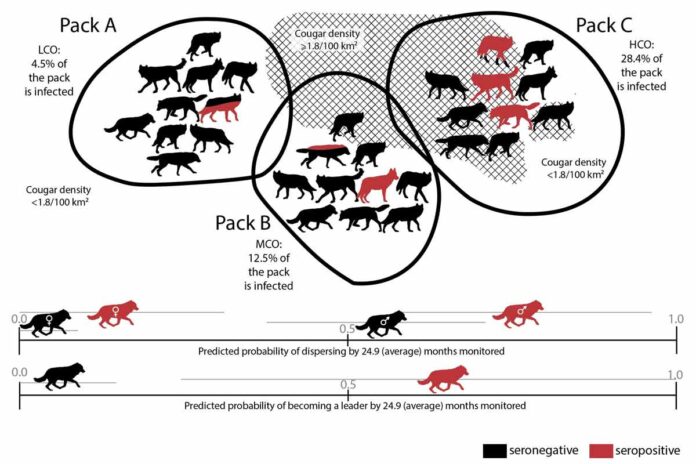According to an analysis of more than 200 North American wolves1, wolves infected with a common parasite are more likely than uninfected animals to lead a pack. Infected animals are also more likely to abandon their packs and venture out on their own.
Toxoplasma gondii, the parasite, makes its hosts bold — a survival mechanism. T. gondii must enter the body of a cat to reproduce sexually, which usually occurs when its host is eaten by one. If the parasite alters the host’s behaviour, making it reckless, this becomes much more likely. Although research findings are mixed, infection in rodents generally correlates with decreased fear of cats and increased exploratory behaviour. People have also shown physical and behavioural changes, such as increased testosterone and dopamine production and increased risk-taking.
Warm-blooded mammals can become infected by eating an infected animal or T. gondii is found in the faeces of infected cats. Cysts form in muscle and brain tissue after an acute infection and persist for the rest of the host’s life. One-third of all humans may be chronically infected.
One-of-a-kind data set
Although T. gondii is known to infect wildlife, few studies have looked into its behavioural effects. In one study, infected hyenas in Kenya were found to be more likely to be eaten by lions2. Connor Meyer and Kira Cassidy, wildlife ecologists at the University of Montana in Missoula, recognised a once-in-a-lifetime opportunity to link infection with behaviour in wild wolves. Data on grey wolves (Canis lupus) collected in Yellowstone National Park, Wyoming, over nearly 27 years. Some wolves in Yellowstone live near cougars (Puma concolor). They are known to carry the parasite, and sometimes steal prey from them. Wolves may become infected by eating cats or their faeces.
The researchers examined 256 blood samples from 229 wolves. These wolves had been closely monitored throughout their lives and had their life histories and social status recorded. Meyer and Cassidy discovered that infected wolves were 11 times more likely than uninfected wolves to abandon their birth family. They are also 46 times more likely to become pack leaders — often the only wolves in the pack to breed.
The study “provides compelling evidence of the profound influence that pathogens can have on the ecology and behaviour of wild animal populations,” according to Dan Macnulty, a wolf biologist at Utah State University in Logan. He goes on to say that it demonstrates the enormous value of long-term research on wolves and other wildlife in Yellowstone National Park.
Effects on the Ecosystem
In the future, the researchers hope to investigate whether infection makes wolves more likely to reproduce successfully. And as well as the effects of low or high infection rates on ecosystems. Individual wolves who disperse may cause wolf populations infected with T. gondii to spread more quickly across a landscape. Aggressive and risk-taking pack leaders may influence how entire packs act. This potentially increases their chances of encountering cougars and infecting more members.
Wolves are known for killing cougars. So, Meyer believes that even brave, risk-taking wolves infected with the parasite are unlikely to become cat food. He hypothesises that infected wolves were more likely to be preyed on by American lions (Panthera atrox). A massive feline predators weighing up to 200 kilogrammes that roamed North America until they became extinct over 11,000 years ago.

